How I Keep Mrs. Pastry Happy

With croissants of course.

Pain au chocolat especially.
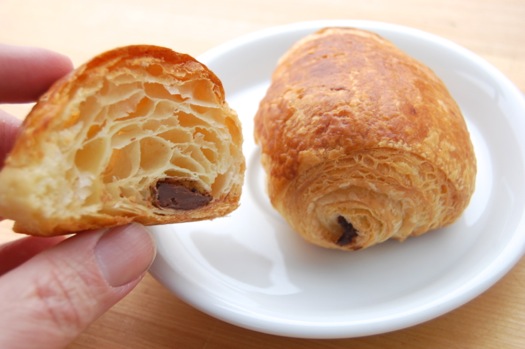
Deliver a few of those and she’ll let me spend the whole weekend laying on the couch watching football. Laminated pastry may or may not have the same effect on your spouse but you won’t know until you try, will you? So here, if you’ve ever wanted to know, is how to make a great croissant.
Start with the croissant dough recipe here. I generally only make about half the finished dough into croissants right away. The rest I freeze for another time (even on her best dayMrs. Pastry couldn’t put away two dozen of these things).
So, starting with about a 1 1/2 pound piece of dough, roll it out into a sheet about 1/8 to 1/4 inch thick. The precise dimensions aren’t terribly important since there is always some overage and trimmings. Speaking of which, trim away any curves.
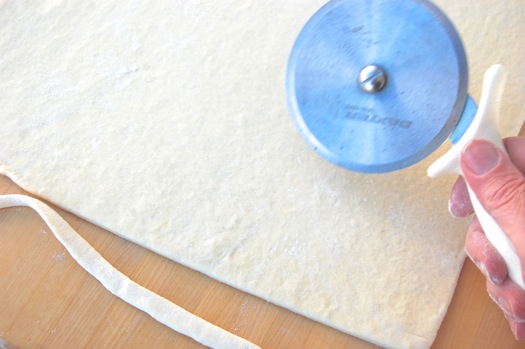
To make standard croissants, cut the dough into rectangles about 4 inches by 8 inches.
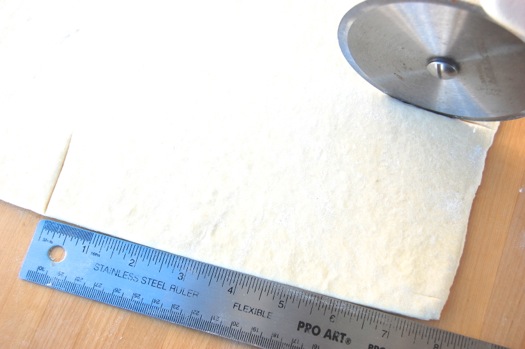
Cut the rectangles from corner to corner into triangles.

You’ll be left with a piece of dough that isn’t quite symmetrical, but that’s OK, the dough is stretchy. Cut a short slit in the fat end.

Gently tug the corners apart and fold the edge over.
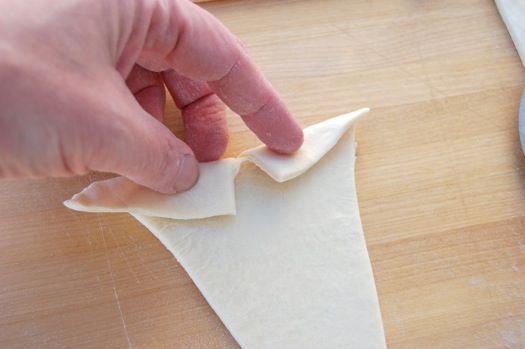
Now, using two hands (not shown) gently tug the point downward as you roll the dough up. You’ll want a long, skinny point at the end…
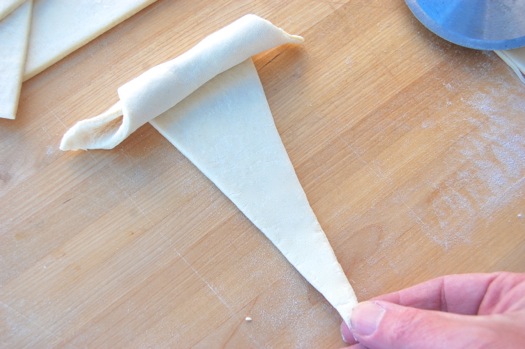
Which you’ll tuck underneath the roll like this, see? This roll is a little long, should be a bit shorter and fatter, but you try this and take pictures at the same time!

Now all you do is lay them out on a sheet pan to proof. Brush them gently with egg wash trying not to get any on the exposed edges, which will glue the layers together. My trick is to brush outward on the various layers on one side, then flip the pan around and do the other side. Works for me.
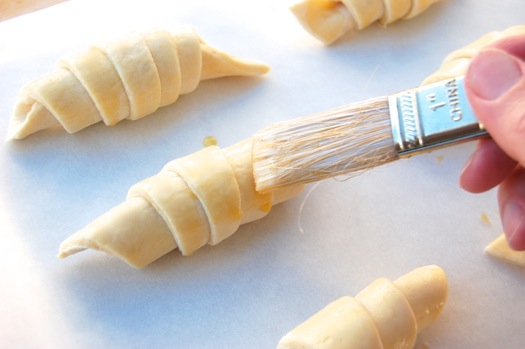
Let them proof 1-2 hours until they’re puffy but not totally soft. Like a fresh marshmallow, not like a cotton ball which is too much. Meanwhile preheat your oven to 400 degrees Fahrenheit.

Bake them for 1o minutes at 400, then lower the temperature and bake another 10-15 at 375 until very brown.

Pain au chocolate (“chocolate bread”) is even easier. For that you just cut rectangles about three inches by five inches. Drop about half an ounce of your favorite chocolate on the end. Here I have a piece of chocolate cut from bar which I warmed in the microwave to make sliceable (2 or 3 five-second shots on high). Use a dark chocolate for this job.
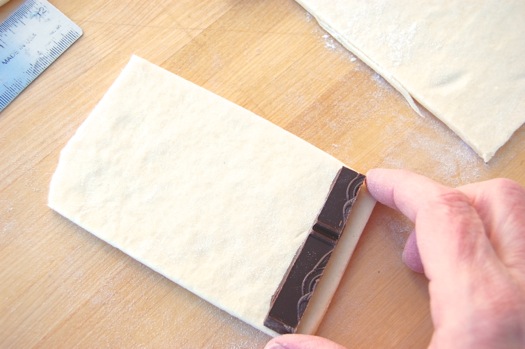
Then just roll it up!
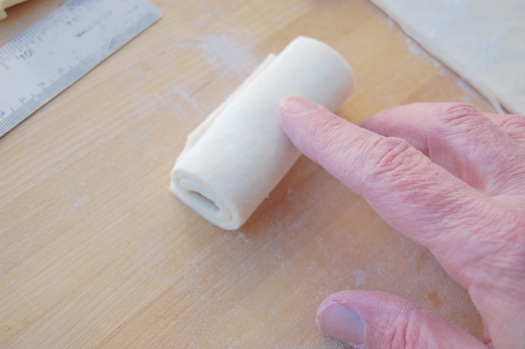
Brush with egg wash, proof and bake just like regular croissants.

For best eating, let them cool down to room temperature…if you can resist them that long.
Joe, how do you freeze the finished croissant dough for later use? Do you wrap up enough for one baking session and then thaw and roll it out and shape, then proof, when you are ready to use it?
Hey Barb! You can do it a couple of ways. I think the best way is to freeze the dough just after it’s been made, then thaw it overnight in the fridge and use it as you would freshly-made dough. However another perfectly good way to go is to shape your croissants, then freeze them. Then as you say, all you need to do is thaw them (again, overnight), proof and bake!
– Joe
I finally made these for breakfast, and they were delicious! One more french treat technique that no longer baffles me – thanks! Next up: revisiting my old nemesis, the sly macaron.
Why not just use puff pastry dough? Is the difference really that important? I’m rather lazy, and would rather not learn 5 different recipes for pastries when I could just use pastry dough for all of them.
Thanks
Hi Ruthi, I’m asked that regularly. And while I appreciate economy as much as the next person, the truth is that croissant dough and puff pastry dough are very different. Croissant dough, because it contains yeast, is more bread-like and so has both a softer and more liable texture and a better flavor. A croissant made of puff pastry would simple shatter when you bit into it. It also would have comparatively little flavor.
On the other hand, croissant dough and Danish dough are similar enough that they could be subsituted for one another if need be. Hope this helps (though it’s probably not what you wanted to hear!).
– Joe
Thanks for the croissant dough and laminating tips Joe! I was previously making average (wife still thought they were delicious) croissants, but with your help I’ve actually made light, fluffy, really tasty croissants. So thrilled! I think the best tip for me was how to add flour to the butter pat and smack it.
Great news, Duane!
That particular point was an a-ha moment for me too, way back when. Not only does it give you more leeway when you’re rolling, the flour also absorbs moisture and creates a lighter interior during baking. Keep up the great work!
– Joe
Joe! Croissants were on my 2012 Baking Bucket List and I did it, thanks to your step by step instructions. I’m no longer intimidated. I will make them all the time now. Quick question though: do you use salted or unsalted butter? I used unsalted pasture butter and thought it could have used just a touch more salt, but the rest of my family disagreed. They said they were perfect. Thought I’d ask you since you didn’t specify. Thanks again 🙂 I’m sharing your website like crazy.
Great news, Lee! Thanks for letting me know. And you’re right, I should have specified. Unsalted butter is always the way to go for a laminated pastry. Well done!
– Joe
Joe Joe Joe Joe Joe……you made all of my guests happy and printed a smile in their face. Call me crazy, I made and baked 6 times your croissant recipe for my annual brunch for my family. I have started last week and rolled 60 croissants and 59 pains au chocolat . They freeze very well. We were 20 and they all left with a box with 2 croissants (nature and chocolate) for tomorrow morning. They will remind them the fun and love we have shared together.
Merci beaucoup d’une famille de Candiac, Quebec.
Thanks again for all your work and exquisites recipes.
Louise
Louise, I read this comment over the weekend but was too busy with my daughter’s first communion festivities to respond right away. Allow me to say that it is one of the most delightful and deeply flattering comments I have ever received. You made my week — my month. I am so pleased by it. Thank you very, very much and please get in touch if I can ever be of help to you.
Your friend,
– Joe
Joe,
These were delicious! These are literally better than any I have purchased. The only thing that would make them better would be if the chocolat had some snap to it. Is there a way to get it tempered?
Hi Randy!
Funny you should say that, the missus has that on her wish list for the perfect pain au chocolat as well. The problem there is that any chocolate you put into one of those will of course melt, causing it to, well…lose its temper. Perhaps a higher quality bittersweet chocolate would give you what you want. Something Swiss with lots of cocoa butter would probably be snappier when it re-firms.
Thanks for the email, Randy!
– Joe
You could inject tempered chocoalte into the pain au chocolat after it cools down, which would give it the snap you are looking for.
Interesting idea!
Thanks Rook!
– Joe
Hi Joe – I am so glad that i found your website – i have always wanted the perfect danish and i made it last night – it was perfect -thank you – i did however mess up my first batch -as i used double the butter quantity but i cant tell you how beautiful the dough felt – can you please assist me into telling me how to utilise this dough – i only realised that i had utilised double the quantity when i was proofing the pastries. i will be making the croissants tonight as thats one of the other things that i could never get right. thanks again
Wow…double the butter, eh? I’m not sure what to tell you other than to try making Danish with it! Failing that perhaps it would work as a crust. Have you tried baking it?
– Joe
Hi,yes i baked the pastry n it smelt great but i had to overbake it or else it would have been too soft,it tasted fine but i found it too rich.i have however made another batch and it came out perfect,thank you
Keep me updated, Shereen…it sounds like you’re doing very, very well with this.
– Joe
Where do you find the chocolate strips?
Hey!
You can get chocolate sticks on the internet, or just break up a chocolate bar, which is what I usually do.
– Joe
Joe,
I was so proud of myself when my first few pain au chocolat turned out perfectly…
But I only made 8 of them and kept the rest of the dough in the fridge and tried again the next day, rising the dough for a little over an hour.
But they didn’t rise enough and were pretty dense in the end. I tried again with a 2 hr rise and it didn’t make a difference.
Any ideas?
Thanks in advance!
Hey Jessica!
I’m so pleased — and so sorry! 😉 It sounds like the second batch might have been over-proofed (i.e. the second rising was too long). Was there much liquid butter in the pan? That would be an indicator.
– Joe
hi joe, is it a bad idea to leave croissant or danish dough overnight in the fridge after laminating ?. i made one at about 2 am and i put it in the fridge and now its the size of a football will it be ok when i roll it out ?.
thanks
It will be. Just push it down to de-gas it and let it cool.
– Joe
Hi Joe, just wanted to let you know I made croissants (more or less) following your directions. They are almost finished baking in the oven, they look like real croissants (!!!!) and the kitchen smells amazing.
Thanks for the laid back and very clear instructions!
Woohoo! Glad they’re working for you, Rhonda! I do love making croissants. Without them Mrs. Pastry would have been done with me many years ago. I hope this is the first of many batches!
– Joe
Hi Joe, Congrat’s you have the best pastry website!!!! 🙂
Question? I love croissants and have tried so many recipes to come up with one that I really like from a local french patisserie. I noticed that their recipe might be a combination of danish & puff pastry.
As soon as you bite in it buttery flaky layers fall everywhere :), but its very soft in the inside and not bread like. I would probably say almost like a pate choux texture. Can’t wait to try your recipes this weekend? Do you suggest that I should try the danish recipe instead of the croissant?
Hi Jessica!
Very interesting question. The thing that normally distinguished one bakery’s croissants from another is the number of “turns” in the dough. Which is to say, some bakers fold theirs a lot and others only a little. More turns yields more flakes, fewer turns fewer flakes. So my suggestion would be to use the croissant recipe but fold it one more time to see if this is closer to the texture you want!
Let me know how it goes!
– Joe
Morning Joe,
When ever I make this recipe my appartment smells AMAZING and the second they leave the oven be it croissant or pain au chocolat they are full and puffy and slightly brown. For some reason thou I can’t get them to stay like that. I litterally see them fall before my eyes. Is there a way to remedy this?
Hi Rook!
That’s frustrating. Sorry to hear it. My suggestion is to bake them longer, past the golden point until they’re dark brown. Most croissants are baked to that point, partly because the rigidity helps to prevent deflation. Also, make sure you’re proofing long enough…you want to make sure the crumb is light and fluffy, not dense, before the pastries go in the oven. An alternate strategy is to take some of the butter (about 25%) out of the formula. That will take some weight out of the dough and lessen the risk of collapse.
Let me know how the next batch goes!
Thanks joe
Let me know how they go, Rook!
– Joe
They turned out perfect. I did end up splicing in vanilla seeds into the butter but, one thing I do need to tell you. There was actual yelp of joy when they came out of the oven fluffy and golden. I do wonder tho why is it that the dough has to sit for four hours before being used? – Rook
Hi Rook!
The resting is simply to allow the butter to form all the way through, and of course to allow gluten to relax. So glad things are going better! Woohoo!
– Joe
I forgot to ask…what specifically did you do differently?
– Joe
Well the first time I tried this recipe I tried to do it from memory. I got salt confused with sugar so that went south. Second time I forgot about the resting and third I was so excited I forgot the egg wash but, now we are all good. Thank you so much
Whew! Glad it all got worked out in the end, Rook!
Thanks for the note!
– Joe
Mr. Pastry!
Thanks to you and your website, I have successfully made my first batch of croissants!
Thanks again!
Fil
http://flic.kr/p/ieyCeP
So, the croissants turned out amazingly delicious (best pain au chocolat I’ve ever had), but I do have a technical question.
The dough was fairly stiff to work with, even after completing the book fold and letting it sit in the refrigerator overnight. Rolling it out into a thin enough rectangle took a lot more work than, say, the Danish dough recipe on your site, and kept wanting to shrink back after each roll. I really had to manhandle the thing to get it to roll out!
Even after I had cut each quarter in half and was trying to tug the short triangle into place to make a more symmetrical croissant shape, it was pretty resistant to being stretched out.
I’m assuming I mixed in too much flour at the beginning. I was trying to get to “soft but not sticky” your recipe says, but I ended up with a pretty elastic, coherent ball of dough. It didn’t even remotely look shaggy when it came time to form the envelope for the butter slab.
Any thoughts?
Thanks again!
Hey Filjr!
Glad to hear everything went so well! Sounds like you have a lot of developed gluten in there, which is part of the problem. That happens to me from time to time, especially with puff pastry. I work the dough too hard and end up wrestling with it after a couple of folds. My suggestion is to use a little less flour as you intuited, then try to economize your effort when you roll the dough so you don’t end up working it unnecessarily. Apply pressure and roll without a whole lot of sharp back-and-forth motions, which will only activate more gluten. Fold and then let the dough have a good rest before you do it again.
Make sense?
– Joe
I just tried making these. They were successful! However- the insides aren’t as light and airy as yours- what can I do better next time to get that texture? I only proofed for about an hour (they seemed done!)- but they are flakier on the inside- I was going for a more holey texture- longer proof?